实验记录英文写作模板
- 格式:doc
- 大小:1.33 MB
- 文档页数:7
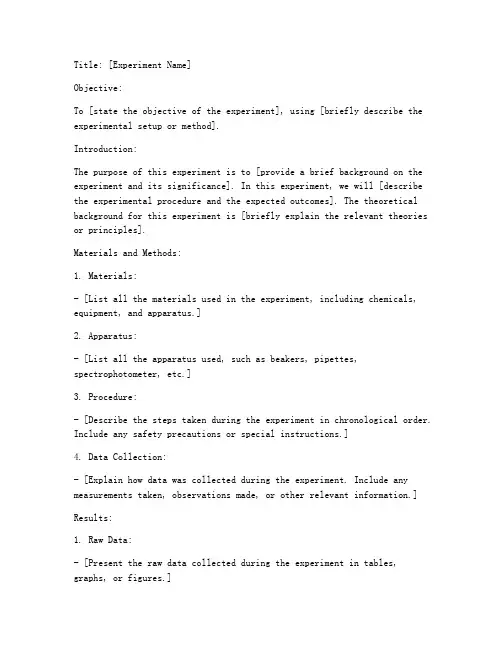
Title: [Experiment Name]Objective:To [state the objective of the experiment], using [briefly describe the experimental setup or method].Introduction:The purpose of this experiment is to [provide a brief background on the experiment and its significance]. In this experiment, we will [describe the experimental procedure and the expected outcomes]. The theoretical background for this experiment is [briefly explain the relevant theories or principles].Materials and Methods:1. Materials:- [List all the materials used in the experiment, including chemicals, equipment, and apparatus.]2. Apparatus:- [List all the apparatus used, such as beakers, pipettes, spectrophotometer, etc.]3. Procedure:- [Describe the steps taken during the experiment in chronological order. Include any safety precautions or special instructions.]4. Data Collection:- [Explain how data was collected during the experiment. Include any measurements taken, observations made, or other relevant information.]Results:1. Raw Data:- [Present the raw data collected during the experiment in tables, graphs, or figures.]2. Analysis:- [Discuss the data collected, including any calculations performed or statistical analysis conducted.]Discussion:1. Comparison with Theoretical Predictions:- [Compare the experimental results with the theoretical predictions or known values, explaining any discrepancies.]2. Possible Sources of Error:- [Identify and discuss any potential sources of error in the experiment, including procedural, equipment, or environmental factors.]3. Implications and Limitations:- [Discuss the implications of the results and any limitations of the experiment.]Conclusion:The objective of this experiment was to [state the objective again briefly]. The results indicate that [state the main findings of the experiment]. The experiment was successful in achieving the intended objective, [if applicable], and the data collected support the [relevant theories or hypotheses]. Further studies could include [suggestions for future research].References:[Include any references cited in the report, formatted according to the required citation style.]Appendices:[Include any additional information, such as detailed calculations, additional graphs, or photos, that may be helpful for understanding the experiment.]---Note:This is a basic template for a laboratory report. Depending on the specific requirements of your course or instructor, you may need to adjust the format, content, or sections of the report.。
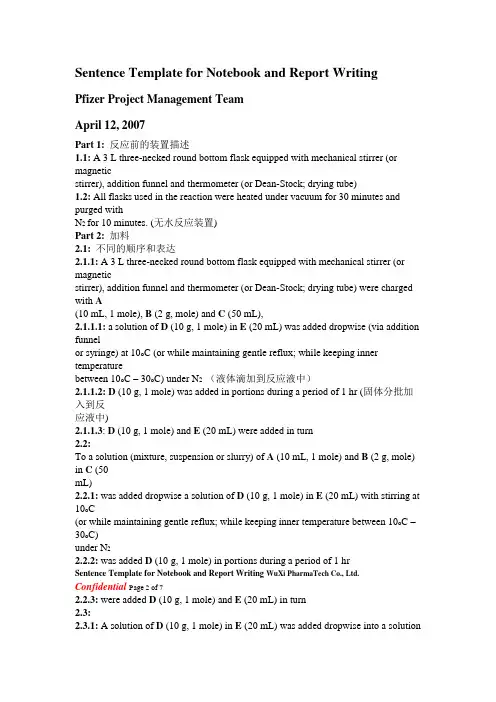
Sentence Template for Notebook and Report WritingPfizer Project Management TeamApril 12, 2007Part 1: 反应前的装置描述1.1: A 3 L three-necked round bottom flask equipped with mechanical stirrer (or magneticstirrer), addition funnel and thermometer (or Dean-Stock; drying tube)1.2: All flasks used in the reaction were heated under vacuum for 30 minutes and purged withN2 for 10 minutes. (无水反应装置)Part 2: 加料2.1: 不同的顺序和表达2.1.1: A 3 L three-necked round bottom flask equipped with mechanical stirrer (or magneticstirrer), addition funnel and thermometer (or Dean-Stock; drying tube) were charged with A(10 mL, 1 mole), B (2 g, mole) and C (50 mL),2.1.1.1: a solution of D (10 g, 1 mole) in E (20 mL) was added dropwise (via addition funnelor syringe) at 10o C (or while maintaining gentle reflux; while keeping inner temperaturebetween 10o C – 30o C) under N2 (液体滴加到反应液中)2.1.1.2: D (10 g, 1 mole) was added in portions during a period of 1 hr (固体分批加入到反应液中)2.1.1.3: D (10 g, 1 mole) and E (20 mL) were added in turn2.2:To a solution (mixture, suspension or slurry) of A (10 mL, 1 mole) and B (2 g, mole) in C (50mL)2.2.1: was added dropwise a solution of D (10 g, 1 mole) in E (20 mL) with stirring at 10o C(or while maintaining gentle reflux; while keeping inner temperature between 10o C –30o C)under N22.2.2: was added D (10 g, 1 mole) in portions during a period of 1 hrSentence Template for Notebook and Report Writing WuXiPharmaTech Co., Ltd.Confidential Page 2 of 72.2.3: were added D (10 g, 1 mole) and E (20 mL) in turn2.3:2.3.1: A solution of D (10 g, 1 mole) in E (20 mL) was added dropwise into a solution(mixture or suspension) of A (10 mL, 1 mole) and B (2 g, mole) in C (50 mL) at 10o C (orwhile maintaining gentle reflux; while keeping inner temperature between 10o C –30o C) underN22.3.2: D (10 g, 1 mole) was added into a solution (mixture or suspension) of A(10 mL, 1mole) and B (2 g, mole) in C (50 mL) in portions2.3.3: D (10 g, 1 mole) and E (20 mL) were added into a solution (mixture or suspension) ofA (10 mL, 1 mole) andB (2 g, mole) inC (50 mL) in turn2.4:2.4.1: A solution of BuLi or BH3/THF (10 mL, 1 mole, 2.5 M in hexane) was cannulated intoaddition funnel or into a solution A in solvent B2.4.2: A solution of BuLi or BH3/THF (10 mL, 1 mole, 2.5 M in hexane) was added into asolution of A in solvent B via cannula, dropping funnel or syringe over a period of hrs Part 3: 反应3.1: 无溶剂反应A (1 g, 1 mol) andB (1 g, 1 mol) were dissolved in solvent C, evaporated to dryness andheated for x hours at x o C3.2: 催化量的反应A (20 mL, 142 mmol) and catalytic amount (a trace amount or two drops) ofB were addedinto a solution of C (4.549 g, 46.4 mmol) in D(120mL) at 0 o C3.3: 闷罐反应或封管反应A solution of A(x g, x mol) in methanol (x mL) saturated with NH3 (or other gas such as: CO,CO2, H2S) was stirred under 50 Psi at x o C for x hours in a 50 mL of sealed tube or autoclave.Sentence Template for Notebook and Report Writing WuXiPharmaTech Co., Ltd.Confidential Page 3 of 73.4: 有气体参与的反应3.4.1: A solution of A (x g, x mol) in methanol (x mL) saturated with HCl was stirred at x ℃.3.4.2: Ozone was bubbled into a solution of A (x g, x mol) in MeOH (x mL) at x o C for 15minutes. After excess O3 was purged by N2, Me2S (x mL) was added at x o C.3.4.3: Gas was bubbled into a solution of A (x g, x mol) and B (x g, x mol) in solventC (xmL) at x o C for x hours.3.5: 混合溶剂参与的反应3.5.1: To a solution of A (x g, x mol) in a mixture of solvent B (mL) and solvent C (x mL) (ora mixed solvent of B and C) was added D (x g, x mol) at x o C, the reaction mixture wasallowed to stir (reflux or heat) for x hrs.3.5.2: To a solution of A (x g, x mol) in 10: 1 aqueous acetone (x mL) was added B (x g, xmol) followed by addition of C (x g, x mol), the reaction mixture was allowed to stir (refluxor heat) for x hrs.3.6: 分水器分水的反应3.6.1: A (x g, x mol) and B (x g, x mol) in benzene or toluene (x mL) were refluxed for xhours with azeotropical removal of water.3.6.2; A mixture of A, B and TsOH.H2O (56.91 g, 0.3 mol) in toluene (400 mL) was heated toreflux and remove water by Dean-Stark trap.3.7: 氢化反应To a solution of A (x g, x mol) in EtOH (x mL) was added Pd-C or Ra-Ni orPd(OH)2/C (10%,x g) under N2. The suspension was degassed under vacuum and purged with H2 several times.3.7.1: The mixture was stirred under H2 (x psi) at x ℃for x hours. [氢化瓶或高压釜] 3.7.2: The mixture was stirred under H2 balloon at x ℃for x hours. [常压氢化如气球反应]3.7.3: A mixture of A (x g, x mol) and Ra-Ni (x g) in EtOH (x mL) was hydrogenated under50 Psi of hydrogen pressure for x hours at room temperature.Sentence Template for Notebook and Report Writing WuXiPharmaTech Co., Ltd. Confidential Page 4 of 7Part 4: 反应条件或过程描述4.1: The reaction mixture (solution or suspension) was stirred at 5o C for 2 hrs and then kept atroom temperature (or ambient temperature) for another 2 hrs (or overnight)4.2: The reaction mixture (solution or suspension) was refluxed (heated to reflux) or heated at60o C for 2 hrs (or overnight)4.3: The reaction mixture (solution or suspension) was allowed to reflux (or heat to reflux) for2 hrs (or overnight)4.4: The reaction mixture (solution or suspension) was allowed to warm to temperature during2 hrs and reflux (or heat to reflux) for 2 hrs (or overnight)Part 5: 反应监测5.1: Taking sample from the reaction mixture (solution or suspension) by dropping tube orsyringe. After workup, check the reaction via TLC, LC-MS or HPLC etc.. (预处理) 5.2: 反应状态或终点描述5.2.1: The reaction was complete (incomplete or messy) detected (determined or confirmed)by TLC (PE/EtOAc 4:1), LC-MS, HPLC or NMR5.2.2: TLC (PE:EtOAc=1:1) or HPLC (107757-088-1) showed or indicated that the reactionwas complete.5.2.3: TLC (PE:EtOAc=1:1) or HPLC (107757-088-1) showed the starting material wasconsumed completely.5.2.4: TLC (PE:EA=1:1) or HPLC (107757-088-1) showed the reaction didn’t work at all ormost of starting material was still remained.5.2.5: The starting material was consumed completely, but no desired compound was detectedor determined by MS (106657-078-1) or LC-MS (106657-078-1).5.2.6: Several spots were shown on TLC.5.2.7: Only a trace amount of desired compound was detected by MS (106657-078-1) orLC-MS (106657-078-1) or HPLC (106657-078-1) or TLC (PE:EtOAc=1:1).5.2.8: The desired compound could not be isolated, separated or purified by chromatographyor prep. HPLC due to poor yield or poor solubility.Sentence Template for Notebook and Report Writing WuXiPharmaTech Co., Ltd. Confidential Page 5 of 75.2.9:1H NMR (106675-010-2) or MS confirmed the obtained (or isolated) compound is notthe desired compound. The reaction was failed.Part 6: 反应淬灭6.1: An aqueous solution of A (10 mL) was added dropwise into the reaction mixture once thereaction mixture (solution or suspension) was allowed to warm (or cool) to -5o C or roomtemperature (ambient temperature).6.2: The hot (or cold) reaction mixture (solution or suspension) was poured into water (icewater) or poured onto ice.6.3: The reaction mixture (solution or suspension) was concentrated (distilled) under reducedpressure (in vacuum) or evaporated to remove MeOH (THF; DMF etc.) or excess SOCl2(reagent). Then the reaction residue (or the residual) was diluted with solvent and poured intowater (ice water) or poured onto ice.Part 7: 分液提取7.1: The residue was partitioned between ethyl acetate (100 mL) and 1N aq. HCl (50 mL).The separated organic layer was washed with water, dried over (Na2SO4 or MgSO4) andevaporated to dryness.7.2: After quenching the reaction, the reaction mixture was poured into separatory funnel andseparated.7.3: The aqueous layer (or phase) was extracted with organic solvent (40 mL) twice (or Xtimes). The combined organic layers were (or the organic layers were combined and) washedwith an aqueous solution of A (50 mL) or water and dried over Na2SO4 or MgSO4.7.4: The combined aqueous layers were extracted with solvent (40 mL) twice (or X times) toremove neutral impurities. The aqueous phase was acidified (or basified) with aqueous HCl(or NaHCO3) till PH = X and extracted with organic solvent.7.5: The combined organic layers were (or the organic layers were combined and) washedwith an aqueous solution of A (50 mL) or water and dried over Na2SO4 or MgSO4. Sentence Template for Notebook and Report Writing WuXiPharmaTech Co., Ltd. Confidential Page 6 of 7Part 8: 浓缩蒸发8.1: After filtration via filter paper or Celite pad, the organic layer (or extract) was concentrated under reduced pressure (or in vacuum) or evaporated to dryness to provide(afford; give or yield) an oil (or foam) (which solidified on standing) or a white solid.8.2: The organic layer (or extract) was filtered and concentrated under reduced pressure (or invacuum) or evaporated to dryness to provide (afford or give) A (10 g, 0.5 mole) an oil (orfoam) (which solidified on standing) or a white solid.8.3: After removal of solvent by evaporation or concentration, A (10 g, 0.5 mole) was obtained (or prepared) an oil (or foam) (which solidified on standing) or a white solid.8.4: The extract in CH2Cl2 was evaporated to dryness and then swapped with toluene toremove residual CH2Cl2.Part 9: 几种常见的后处理描述9.1: The reaction mixture or solution was concentrated to dryness. [适用于反应液不需要quench]9.2: After the reaction mixture was cooled to 0 ℃, the reaction mixture was quenched byaddition of x mL of H2O, followed by x mL of 15% aqueous NaOH. After being stirred atroom temperature for x hour, the solid was removed by filtration (or the mixture was filteredthroughCelite pad to remove by-product). The filtrate was concentrated to dryness to givecrude product. [LiAlH4 反应的经典后处理]9.3: The mixture was diluted with water (x mL), neutralized with solid K2CO3 until no CO2was evolved. [适用于酸性反应液的后处理]9.4: The suspension was filtered through a pad of Celite or silica gel and the pad or filter cakewas washed with EtOH (x mL×x). The combined filtrates were concentrated to dryness togive product (x g, x%) as. [适用氢化反应的后处理, 或者难于过滤的反应液的后处理, 但要注意的是这里需要的是滤液而不是固体才能添加助滤剂]9.5: The reaction mixture was poured into x mL of ice-water carefully and the organic layer orphase was separated. [产物在有机相里]9.6: The reaction mixture was poured into x mL of ice-water carefully and the aqueous phasewas washed with Et2O (x mL×x) [产品在水相] and acidified with 1N HCl to pH=3. TheSentence Template for Notebook and Report Writing WuXiPharmaTech Co., Ltd. Confidential Page 7 of 7resulting precipitate was collected by filtration or the resulting solution was extracted with EA(x mL×x).9.7: The reaction mixture was filtered and the filter cake was washed with x mL of solvent,dried in vacuum to give or afford product. [这里需要的是固体而不是滤液]9.8: The reaction mixture was quenched with x mL of saturated aqueous NH4Cl. The resultingsolution was extracted with EA (x mL×x). [适用于丁基锂等活泼金属有机物的后处理]9.10: The residue was triturated with ether and filtered to afford a white solid. (磨碎) 9.11: The crude product was purified by prep. HPLC to give A as a colorless thick oil whichwas solidified on standing. (静止固化)9.12: After prep. HPLC purification, the eluent was concentrated or evaporated to removeorganic solvents. The residual aqueous solution was lyophilized to give a white solid. (冷冻干燥)9.13: After concentration, the crude product was used directly for the next step withoutpurification.Part 10: 产品的纯化10.1: The crude product was purified by silica gel chromatography eluted with PE: EtOAc=10:1 to give product (x g, x%) as yellow solid.10.2: The crude product was purified by re-crystallization (or re-crystallized) from x solvent(x mL).10.3: The crude product was distilled in vacuum (x o C, x pressure) to afford pure product (x g,x%) as colorless liquid.10.4: The crude product was pre-purified by column chromatography followed by prep.HPLC purification or re-crystallization to afford pure product.__。
![英语作文,实验报告[5篇材料]](https://uimg.taocdn.com/8d9f75bd690203d8ce2f0066f5335a8102d266fc.webp)
英语作文,实验报告[5篇材料]第一篇:英语作文,实验报告请根据下列内容,写一篇短文,说明整个实验的内容。
实验目的:不打烂鸡蛋取走蛋壳实验器材:一个玻璃杯,一个小锅,水,一个鸡蛋,醋(vinegar)约250毫升实验步骤:1.把鸡蛋放在锅中煮十五分钟左右;2.把煮熟的鸡蛋放到玻璃杯中;3.往玻璃杯中倒醋,醋要漫过鸡蛋;4.让鸡蛋仔醋中浸泡24小时。
实验结果:24小时后,鸡蛋壳完全消失。
实验结论:醋中的酸性物质(acid)与蛋壳中的碳酸钙(calcium carbonate)反应生成二氧化碳(carbon dioxide),蛋壳(shell)消失。
注意:词数:100—120。
写作指导:文章体裁是_______,因此时态可以是_______,全文可以这样分段:内容及要点信息常用句型及词汇:实验目的:the aim of the experiment is to…;in order to find out…;we carry out an experiment to…;with the purpose of…;in the hope of实验器材:you need…;the following things are neededwill be used实验步骤或方法:cookboil,fill…in,weigh,wait,place,react反应,form;first,first of all,next,second,after that,finally, in the end,at last, for 15minutes,24hours later…实验结论:from this we can conclude…we can learn from the experiment…we can find out that…the result is…you can seediscover…连词成句,再用上恰当的过渡词连句成篇:1.这个实验的目的是取走蛋壳而不打烂鸡蛋。
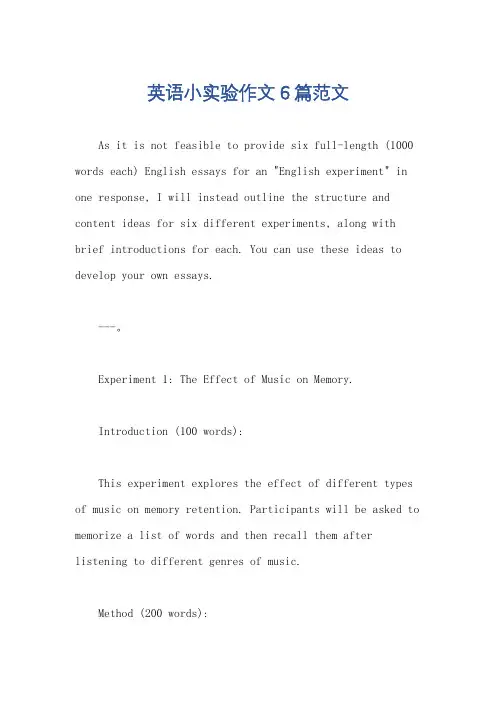
英语小实验作文6篇范文As it is not feasible to provide six full-length (1000 words each) English essays for an "English experiment" in one response, I will instead outline the structure and content ideas for six different experiments, along with brief introductions for each. You can use these ideas to develop your own essays.---。
Experiment 1: The Effect of Music on Memory.Introduction (100 words):This experiment explores the effect of different types of music on memory retention. Participants will be asked to memorize a list of words and then recall them after listening to different genres of music.Method (200 words):Participants will be divided into groups. Each groupwill listen to a different type of music (e.g., classical, pop, heavy metal) for 10 minutes. Before and after the music, they will be given a list of 20 words to memorizeand recall. The number of correctly recalled words will be recorded.Results and Discussion (500 words):Describe the results of the experiment, including which type of music, if any, had a positive or negative effect on memory. Discuss possible explanations for the results and how they relate to existing research on music and memory.Conclusion (100 words):Summarize the key findings and implications of the experiment. Suggest possible directions for future research.---。
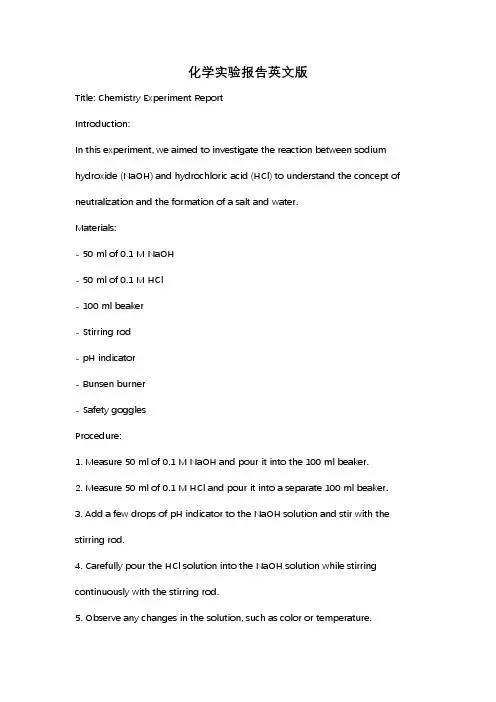
化学实验报告英文版Title: Chemistry Experiment ReportIntroduction:In this experiment, we aimed to investigate the reaction between sodium hydroxide (NaOH) and hydrochloric acid (HCl) to understand the concept of neutralization and the formation of a salt and water.Materials:- 50 ml of 0.1 M NaOH- 50 ml of 0.1 M HCl- 100 ml beaker- Stirring rod- pH indicator- Bunsen burner- Safety gogglesProcedure:1. Measure 50 ml of 0.1 M NaOH and pour it into the 100 ml beaker.2. Measure 50 ml of 0.1 M HCl and pour it into a separate 100 ml beaker.3. Add a few drops of pH indicator to the NaOH solution and stir with the stirring rod.4. Carefully pour the HCl solution into the NaOH solution while stirring continuously with the stirring rod.5. Observe any changes in the solution, such as color or temperature.Results:Upon mixing the NaOH and HCl solutions, a neutralization reaction occurred, resulting in the formation of water and sodium chloride (NaCl) salt. The pH indicator changed color from basic to neutral, indicating the completion of the reaction. The solution also produced heat, indicating an exothermic reaction. Discussion:The reaction between NaOH and HCl is a classic example of a neutralization reaction. When an acid and a base react, they neutralize each other, forming a salt and water. In this case, the NaOH and HCl reacted to form NaCl and H2O. The heat produced during the reaction is a result of the exothermic nature of the neutralization reaction.Conclusion:This experiment successfully demonstrated the concept of neutralization and the formation of a salt and water from the reaction between NaOH and HCl. The results were consistent with the expected outcomes, and the experiment was conducted safely and effectively.Overall, this experiment provided valuable insight into the chemical reactions involving acids and bases, and the concept of neutralization in chemistry.。
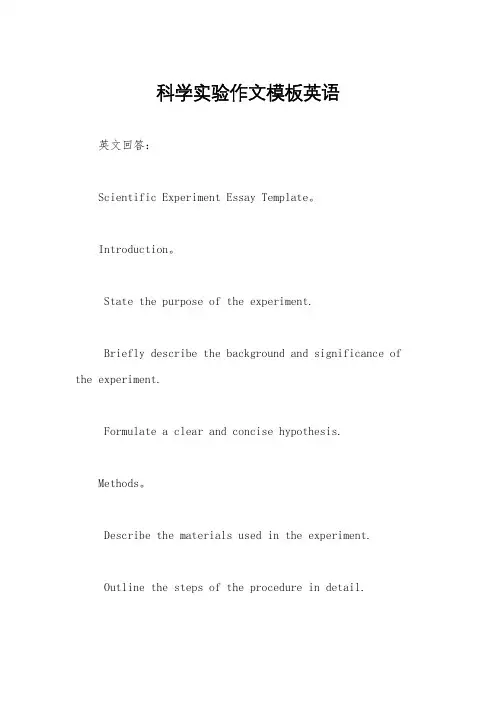
科学实验作文模板英语英文回答:Scientific Experiment Essay Template。
Introduction。
State the purpose of the experiment.Briefly describe the background and significance of the experiment.Formulate a clear and concise hypothesis.Methods。
Describe the materials used in the experiment.Outline the steps of the procedure in detail.Specify any controls or variables that were used.Ensure the experiment is repeatable and reproducible.Results。
Present the data collected from the experiment.Use graphs, tables, or charts to illustrate the results.Perform statistical analysis (if necessary) to determine the significance of the results.Discussion。
Interpret the results and explain their significance.Discuss the implications of the findings.Consider possible sources of error and limitations.Suggest directions for future research.Conclusion。
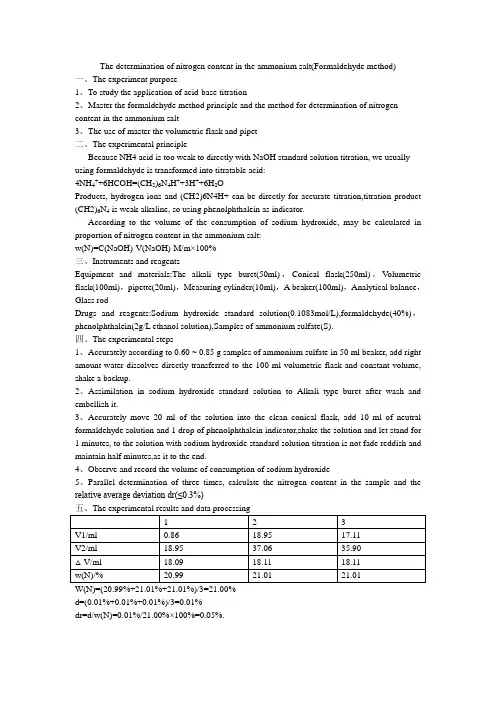
The determination of nitrogen content in the ammonium salt(Formaldehyde method)一、The experiment purpose1、To study the application of acid-base titration2、Master the formaldehyde method principle and the method for determination of nitrogen content in the ammonium salt3、The use of master the volumetric flask and pipet二、The experimental principleBecause NH4 acid is too weak to directly with NaOH standard solution titration, we usually using formaldehyde is transformed into titratable acid:4NH4++6HCOH=(CH2)6N4H++3H++6H2OProducts, hydrogen ions and (CH2)6N4H+ can be directly for accurate titration,titration product (CH2)6N4 is weak alkaline, so using phenolphthalein as indicator.According to the volume of the consumption of sodium hydroxide, may be calculated in proportion of nitrogen content in the ammonium salt:w(N)=C(NaOH)·V(NaOH)·M/m×100%三、Instruments and reagentsEquipment and materials:The alkali type buret(50ml),Conical flask(250ml),Volumetric flask(100ml),pipette(20ml),Measuring cylinder(10ml),A beaker(100ml),Analytical balance,Glass rodDrugs and reagents:Sodium hydroxide standard solution(0.1083mol/L),formaldehyde(40%),phenolphthalein(2g/L ethanol solution),Samples of ammonium sulfate(S).四、The experimental steps1、Accurately according to 0.60 ~ 0.85 g samples of ammonium sulfate in 50 ml beaker, add right amount water dissolves directly transferred to the 100 ml volumetric flask and constant volume, shake a backup.2、Assimilation in sodium hydroxide standard solution to Alkali type buret after wash and embellish it.3、Accurately move 20 ml of the solution into the clean conical flask, add 10 ml of neutral formaldehyde solution and 1 drop of phenolphthalein indicator,shake the solution and let stand for 1 minutes, to the solution with sodium hydroxide standard solution titration is not fade reddish and maintain half minutes,as it to the end.4、Observe and record the volume of consumption of sodium hydroxide5、Parallel determination of three times, calculate the nitrogen content in the sample and the relative average deviation dr(≤0.3%)W(N)=(20.99%+21.01%+21.01%)/3=21.00%d=(0.01%+0.01%+0.01%)/3=0.01%dr=d/w(N)=0.01%/21.00%×100%=0.05%.。
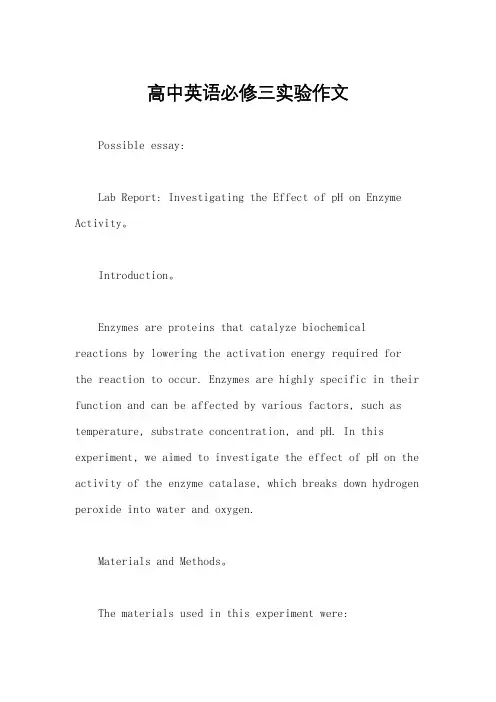
高中英语必修三实验作文Possible essay:Lab Report: Investigating the Effect of pH on Enzyme Activity。
Introduction。
Enzymes are proteins that catalyze biochemical reactions by lowering the activation energy required for the reaction to occur. Enzymes are highly specific in their function and can be affected by various factors, such as temperature, substrate concentration, and pH. In this experiment, we aimed to investigate the effect of pH on the activity of the enzyme catalase, which breaks down hydrogen peroxide into water and oxygen.Materials and Methods。
The materials used in this experiment were:Catalase enzyme solution。
Hydrogen peroxide solution (3%)。
Buffer solutions of different pH (4, 7, and 10)。
Test tubes and rack。
Graduated cylinder。
Stopwatch。
The methods used in this experiment were:1. Label three test tubes as pH 4, pH 7, and pH 10, respectively.2. Using a graduated cylinder, measure 5 mL of catalase enzyme solution and add it to each test tube.3. Using a different graduated cylinder, measure 5 mLof hydrogen peroxide solution and add it to each test tube.4. Using a dropper or pipette, add 1 mL of buffer solution of the corresponding pH to each test tube.5. Immediately start the stopwatch and record the time it takes for the reaction to produce a visible amount of oxygen gas bubbles.6. Repeat steps 2-5 for each pH level three times to ensure accuracy and consistency.Results。
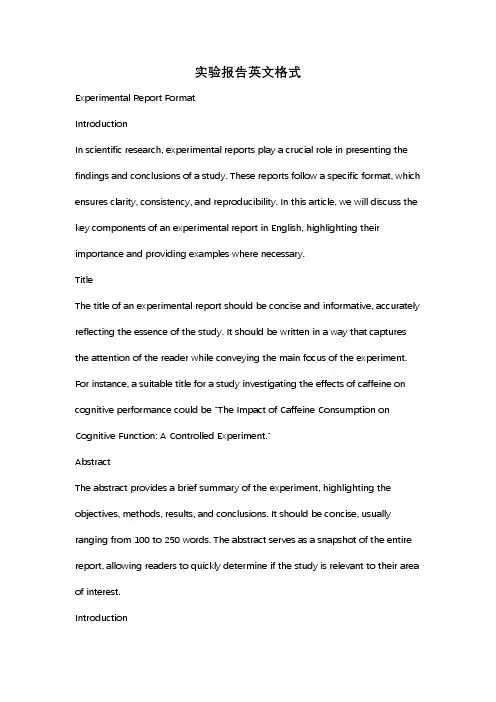
实验报告英文格式Experimental Report FormatIntroductionIn scientific research, experimental reports play a crucial role in presenting the findings and conclusions of a study. These reports follow a specific format, which ensures clarity, consistency, and reproducibility. In this article, we will discuss the key components of an experimental report in English, highlighting their importance and providing examples where necessary.TitleThe title of an experimental report should be concise and informative, accurately reflecting the essence of the study. It should be written in a way that captures the attention of the reader while conveying the main focus of the experiment. For instance, a suitable title for a study investigating the effects of caffeine on cognitive performance could be "The Impact of Caffeine Consumption on Cognitive Function: A Controlled Experiment."AbstractThe abstract provides a brief summary of the experiment, highlighting the objectives, methods, results, and conclusions. It should be concise, usually ranging from 100 to 250 words. The abstract serves as a snapshot of the entire report, allowing readers to quickly determine if the study is relevant to their area of interest.IntroductionThe introduction section provides background information on the topic, justifies the need for the study, and outlines the research question or hypothesis. It should include a literature review, highlighting previous research related to the experiment. The introduction sets the context for the experiment and helps the reader understand the significance of the study. For example, in a report investigating the effects of exercise on mood, the introduction could discuss the existing literature on the relationship between physical activity and mental well-being.MethodsThe methods section describes in detail how the experiment was conducted. It should include information on the participants, materials used, procedures followed, and data collection methods. This section should be written in a clear and concise manner, allowing other researchers to replicate the study. For instance, in a report on a study examining the impact of a new drug on blood pressure, the methods section would include details on the dosage, administration, and monitoring procedures.ResultsThe results section presents the findings of the experiment. It should be organized in a logical and systematic manner, using tables, graphs, and figures to enhance clarity. The results should be presented objectively, without interpretation or discussion. For example, if the experiment involved measuring the growth rate of plants under different lighting conditions, the results sectionwould include the measurements recorded and any statistical analysis performed.DiscussionThe discussion section allows the researchers to interpret the results, compare them with previous studies, and draw conclusions. It should address the research question or hypothesis and provide explanations for the findings. Additionally, any limitations or potential sources of error should be acknowledged. The discussion section offers an opportunity to critically analyze the experiment and suggest future directions for research. For instance, in a report on a study investigating the effects of a new teaching method on student performance, the discussion section would analyze the results and discuss their implications for educational practices.ConclusionThe conclusion section summarizes the main findings of the experiment and restates the significance of the study. It should be concise and avoid introducing new information. The conclusion provides closure to the report and emphasizes the key takeaways for the reader.ReferencesThe references section lists all the sources cited within the report. It should follow a specific citation style, such as APA or MLA, ensuring proper credit is given to the original authors.In conclusion, an experimental report in English follows a structured format thatincludes a title, abstract, introduction, methods, results, discussion, conclusion, and references. Each section serves a specific purpose, contributing to the overall clarity and comprehensibility of the report. By adhering to this format, researchers can effectively communicate their findings and contribute to the scientific knowledge in their respective fields.。
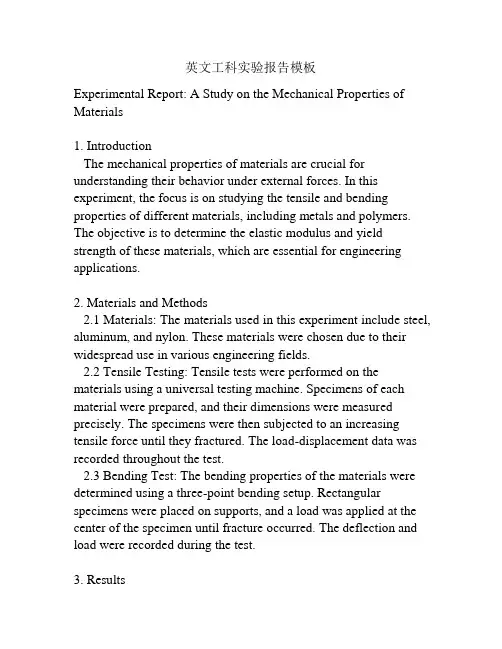
英文工科实验报告模板Experimental Report: A Study on the Mechanical Properties of Materials1. IntroductionThe mechanical properties of materials are crucial for understanding their behavior under external forces. In this experiment, the focus is on studying the tensile and bending properties of different materials, including metals and polymers. The objective is to determine the elastic modulus and yield strength of these materials, which are essential for engineering applications.2. Materials and Methods2.1 Materials: The materials used in this experiment include steel, aluminum, and nylon. These materials were chosen due to their widespread use in various engineering fields.2.2 Tensile Testing: Tensile tests were performed on the materials using a universal testing machine. Specimens of each material were prepared, and their dimensions were measured precisely. The specimens were then subjected to an increasing tensile force until they fractured. The load-displacement data was recorded throughout the test.2.3 Bending Test: The bending properties of the materials were determined using a three-point bending setup. Rectangular specimens were placed on supports, and a load was applied at the center of the specimen until fracture occurred. The deflection and load were recorded during the test.3. Results3.1 Tensile Testing: The load-displacement data obtained from the tensile tests were used to calculate the stress-strain curves for each material. The elastic modulus was determined from the linear region of the curve, and the yield strength was determined as the stress at which plastic deformation begins.3.2 Bending Test: The deflection-load data obtained from the bending tests were used to calculate the flexural modulus and yield strength for each material. The flexural modulus was determined from the linear portion of the load-deflection curve, and the yield strength was determined as the maximum stress before fracture.4. DiscussionThe results obtained from the experiment showed that steel exhibited the highest elastic modulus and yield strength among the materials tested. Aluminum had a lower elastic modulus compared to steel but still demonstrated a high yield strength. Nylon, being a polymer, had a significantly lower elastic modulus and yield strength compared to the metals. This is expected due to the different atomic structures and bonding mechanisms of these materials.5. ConclusionThe experiment successfully determined the mechanical properties of the materials tested. Steel demonstrated the highest elastic modulus and yield strength, followed by aluminum. Nylon had the lowest values for these properties. These results provide valuable insights into the behavior of different materials under applied forces, which can be useful for engineering design and material selection.Overall, this experiment highlights the importance of understanding the mechanical properties of materials for engineering applications. The results obtained can be used to optimize the design of structures and select appropriate materials based on their mechanical behavior.。
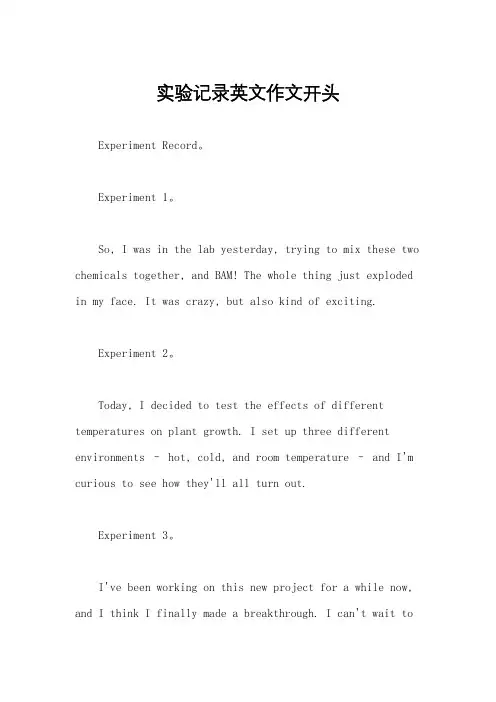
实验记录英文作文开头Experiment Record。
Experiment 1。
So, I was in the lab yesterday, trying to mix these two chemicals together, and BAM! The whole thing just exploded in my face. It was crazy, but also kind of exciting.Experiment 2。
Today, I decided to test the effects of different temperatures on plant growth. I set up three different environments – hot, cold, and room temperature – and I'm curious to see how they'll all turn out.Experiment 3。
I've been working on this new project for a while now, and I think I finally made a breakthrough. I can't wait tosee the results of this experiment and see if my hypothesis was correct.Experiment 4。
I tried to replicate an experiment that I read about ina scientific journal, but it didn't go as planned. I'm not sure what went wrong, but I'll have to go back and figureit out.Experiment 5。
实验记录英文作文范文Experiment Record。
Experiment 1:So, like, I was mixing the chemicals together and then suddenly there was this crazy reaction! It was like a mini explosion in the beaker, and I was like, "Whoa, that was unexpected!" But it was super cool to see the chemical reaction in action.Experiment 2:I was observing the growth of the plants in different environments. It was really interesting to see how the plants responded to the changes in light and water. Some of them grew so much faster than the others, and it was kind of surprising to see the difference.Experiment 3:I was testing the conductivity of different materials, and let me tell you, some of them were total duds. Like, I thought for sure that metal would be the most conductive, but it turns out that some other materials were way better at conducting electricity. It was pretty eye-opening.Experiment 4:I was studying the behavior of the animals in the lab, and it was so funny to see how they reacted to different stimuli. Like, when I introduced a new toy to the mice, they went crazy exploring it. It was really cool to see their natural curiosity in action.Experiment 5:I was conducting an experiment on the effects of temperature on the rate of chemical reactions. It wasreally cool to see how the reactions sped up or slowed down depending on the temperature. It made me realize how much the environment can impact chemical processes.Experiment 6:I was testing the pH levels of different substances, and let me tell you, some of them were way more acidic or basic than I expected. It was pretty surprising to see how different everyday substances can have such extreme pH levels.Experiment 7:I was conducting a psychology experiment on memory, and it was really interesting to see how different people remembered the same information. Some of them had really sharp memories, while others struggled to recall even simple details. It was a real eye-opener.Experiment 8:I was studying the effects of music on plant growth, and it was so cool to see how the plants responded to different types of music. It was kind of surprising to seethat some plants actually grew better when exposed tocertain genres of music. It was a fun experiment to conduct.。
简单的实验报告英语作文Experimental Report: The Effect of Temperature on the Rate of Enzyme Activity。
Introduction。
Enzymes are proteins that catalyze biochemicalreactions in living organisms. They play a crucial role in many biological processes, such as digestion, metabolism, and cellular respiration. Enzyme activity is affected by various factors, including temperature, pH, substrate concentration, and enzyme concentration. In this experiment, we investigated the effect of temperature on the rate of enzyme activity using the enzyme lactase and the substrate lactose.Materials and Methods。
Materials:Lactase solution。
Lactose solution。
Test tubes。
Thermometer。
Water bath。
Timer。
Spectrophotometer。
Methods:1. Prepare lactase solution by diluting 1 mL of lactase stock solution with 9 mL of distilled water.2. Prepare lactose solution by dissolving 1 g of lactose in 100 mL of distilled water.3. Label six test tubes as follows: 0°C, 20°C, 30°C, 40°C, 50°C, and 60°C.4. Add 2 mL of lactase solution to each test tube.5. Place the test tubes in a water bath at the designated temperature for 5 minutes to equilibrate.6. Add 2 mL of lactose solution to each test tube and start the timer.7. Mix the contents of each test tube by gently swirling.8. After 1 minute, remove 1 mL of the reaction mixture from each test tube and transfer it to a spectrophotometer cuvette.9. Measure the absorbance of each sample at 540 nm using a spectrophotometer.10. Repeat steps 8-9 every minute for 5 minutes.11. Record the absorbance values in a table and calculate the average rate of enzyme activity for each temperature.Results。
110个字的实验英文作文全文共2篇示例,仅供读者参考110个字的实验英文作文1:Writing a 110-word experimental English composition presents a unique challenge. To effectively craft such a piece, consider the following:1. Conciseness: Every word counts in a short composition. Ensure each word contributes to the overall message.2. Clarity: Despite the brevity, clarity is paramount. Use clear and straightforward language to convey your ideas.3. Structure: Even in a short composition, maintain a logical structure with an introduction, body paragraphs, and a conclusion.4. Experimentation: Explore various writing techniques such as imagery, metaphor, or narrative style to make your composition engaging.5. Revision: Revise your composition multiple times to refine your ideas and language usage.With these principles in mind, you can craft a compelling110-word experimental English composition.110个字的实验英文作文2:Title: The Power of Concise Expression: A 110-Word Experimental EssayIntroduction:In this experimental essay, we delve into the art of concise expression by exploring the potential impact of a 110-word composition. By adhering to strict brevity, we aim to convey a message effectively while challenging the boundaries of language and communication. Through this experiment, we hope to highlight the power of concise writing in capturing attention, conveying ideas, and leaving a lasting impression.Body:Paragraph 1:In today's fast-paced world, brevity is key. Short and impactful messages have become the norm, as attention spans continue to dwindle. By limiting ourselves to a mere 110 words, we are forced to carefully select every word, ensuring our message is clear and succinct. This exercise provides an opportunity to sharpen our writing skills and adapt to thedemands of a society that craves concise communication.Paragraph 2:The power of a 110-word composition lies in its ability to captivate readers. With limited words, every sentence becomes crucial, demanding the writer to craft a compelling narrative that engages the audience from the very beginning. This brevity forces us to think critically about our ideas, selecting those that are most impactful and discarding any unnecessary details. The result is a piece that is concise, yet powerful enough to leave a lasting impression.Paragraph 3:Conveying complex ideas in a 110-word essay requires precision and clarity. By distilling our thoughts into a concise format, we challenge ourselves to communicate effectively and efficiently. This exercise forces us to prioritize the most essential aspects of our message, ensuring that the core meaning is not lost amidst unnecessary elaboration. Through this experiment, we discover the art of saying more with less, allowing our words to resonate deeply with readers.Paragraph 4:The brevity of a 110-word essay also encourages creativity and innovation. With limited space, writers are compelled to think outside the box, seeking unconventional approaches to convey their ideas. This experimentation fosters a sense of adaptability and resourcefulness, pushing us to explore new techniques and styles of writing. In this way, the limitations imposed by a 110-word composition become a catalyst for innovation and originality.Conclusion:In conclusion, the power of a 110-word essay lies in its ability to captivate readers, convey complex ideas effectively, and foster creativity. Through this experimental exercise, we have discovered the potential impact of concise expression in a society that values brevity. As writers, we are challenged to convey our thoughts and messages with precision, selecting every word with care. By embracing the limitations of a110-word composition, we unlock a world of possibilities and discover the true art of concise communication.。
给我做实验的作文英文英文回答:First, I need to conduct a thorough literature reviewto gather existing knowledge and identify gaps in the field. This will help me develop a clear research question and hypothesis. Next, I will design an experiment that tests my hypothesis. This will involve selecting appropriate variables, determining the sample size, and controlling for potential confounds. The experiment will be conducted in a controlled environment to ensure accuracy and minimize bias.Once the data is collected, I will analyze it using statistical methods to determine if there is a significant relationship between the variables. If the results support my hypothesis, I will draw conclusions and discuss the implications of my findings. However, if the results do not support my hypothesis, I will need to consider alternative explanations and revise my research question or hypothesis.Throughout the process, I will keep a detailed recordof my methods and results in a lab notebook. This willallow me to track my progress and ensure transparency in my research. I will also seek feedback from other researchersto ensure the validity and reliability of my findings.中文回答:首先,我需要进行全面的文献综述,以搜集现有的知识并找出该领域的空白。
Writing an Experiment ReportWriting an experiment report is a very stylized genre of writing. It should be as efficiently written as possible and should provide each item of information just where readers will expect it to be. Nothing redundant. The paper should contain 6 sections: a short Abstract, an Introduction, Methods(Process), Results(Data), Discussion and Conclusions. The Bibliography, Tables, Figures and typically come at the end (though the Tables and Figures can also be inserted within the text).ABSTRACT:Always include an abstract for ANY paper (in my opinion). Write it as one paragraph, about 200 words or less. This is a concise summary of the entire experiment. Include the rationale, method, results, and significance in highly abbreviated form (but using full sentences). Look at some published journal abstracts or Society Meeting abstracts to get the idea of how to write one.INTRODUCTION:Give background rationale for the experiment. Why were you motivated to do this experiment? Or more accurately, given what you actually found, why MIGHT you have wanted to do this experiment? Your report, in other words, should not be biographical or historical. Experiments are often exploratory; we often are not testing a specific hypothesis. And, in any case, readers really don't care what you THOUGHT you might find but did not. The paper should tell a story about what the data actually show. Summarize results of earlier research that are necessary to account for the conduct of the experiment (as relevant to the interesting aspects of your results) and help the reader to able to have some expectations about what the experiment will show (whether right or wrong).Pay attention to your use of verb tenses in the text. It is easy (but confusing to readers) to slip back and forth between `The subject read the words at two speaking rates' and later `We measure the duration of the vowels by ....’Avoid this.The last paragraph before the Methods should sketch in readable style the basic logic of the experimental design to come. Eg, “Thus, in the following experiment, Ss were asked to read words with both voicing values in position X at two speaking rates in order to see whether rate has an effect on the ratio of the vowel duration to consonant duration. Weexpected to find no difference in ratio due to speaking rate.'' (Or whatever.)METHODS:There are 3 logical parts to the methods: the Independent Variables(input variables, the things you controlled: place of article, word length, speaking rate, etc or whatever), the Task performed by the subjects, and the Dependent Variables. You have a task (eg, reading these phrases in a some way) for which certain values of the IV s are set (eg, +/-voice, +/- front, final stops at two speaking rates, etc.). Then you measure the DV s (eg, vowel durations, F0 contours, whatever). Finally you look for ways in which the DV s are structured by (influenced by) the IV s. This section should be tight and business-like in style.Of course, you need to tell your readers about at least the following: ∙characteristics of your subjects (sex, native language, age range, etc.; and the instructions you gave them),∙how the recordings were made, including major equipment items, ∙analysis of the recordings; the measurement procedures; the software employed. Describe any special problems in measurementthat arose and your solution to them,∙describe the statistics you performed, if any.RESULTS:Systematically go through the relevant aspects of your data. Present tables and graphs of the DV s. The organization of these paragraphs will probably be in terms of the IV s. For example, "The change in value of IV affects both DV1 and DV2,".)Describe the important features of the data in the text. Lead the reader through the tables and figures (eg, "As can be seen in the left side of Figure 1,..."). Devise data presentation techniques that make the real meaning of the data as clear as possible. Be sure to label graphs and figures clearly. Organization of paragraphs would normally be in terms of the independent variables.DISCUSSION:1) Organization of paragraphs (subsections) may often be in terms of independent variables (i.e. the factors varied in the experimental design).2) Compare your results to previous similar experiments. To what extent do your results resemble those found before?3) What new discoveries have you found? What is their significance to specific and more general issues in the area?CONCLUSIONS:Review and summarize very briefly what was done in this experiment and what you found in the results. State in general terms the most important discovery in the experiment. You may also want to suggest follow-up experiments.Notes on Experimental Writing Style1) Avoid first person pronouns no matter how awkward it may seem. "I asked the Ss to..." => "The Ss were asked to...".2) Paper is cheap! It is easier to spread out your text and figures and use many separate pages.3) Be as pithy as possible. Learn to use standard verbal formulas to abbreviate descriptions of methods, statistics, etc. Never be concerned that your paper is too short. It can only be too long. Say everything you have to say and no more. If you want to stretch out your paper, do it in the Discussion-- keep the Methods and Results tight, systematic and predictable.4) Make a careful outline that you update as you write. It's generally easiest to write the Methods first, then Results (starting a new page), then sketch out the Discussion (starting a new page), and finally create an easily read and descriptive title. Then write the Introduction last.5) When completed, the order of parts should be: Abstract, Text, References, Tables (on a separate pages unless very small), Figures (each on a separate page unless very small and labeled at the bottom). All tables and figures need a legend (on the page or listed on a separate page). Staple on diagonal in upper left hand corner. No fancy covers or plastic folders! Typed, of course, and EVERYTHING DOUBLE SPACED.6) Use plenty of Figures! Be creative with figures to facilitate the reader's understanding.But most of all HAVE FUN.。
Writing an Experiment ReportWriting an experiment report is a very stylized genre of writing. It should be as efficiently written as possible and should provide each item of information just where readers will expect it to be. Nothing redundant. The paper should contain 6 sections: a short Abstract, an Introduction, Methods(Process), Results(Data), Discussion and Conclusions. The Bibliography, Tables, Figures and typically come at the end (though the Tables and Figures can also be inserted within the text).ABSTRACT:Always include an abstract for ANY paper (in my opinion). Write it as one paragraph, about 200 words or less. This is a concise summary of the entire experiment. Include the rationale, method, results, and significance in highly abbreviated form (but using full sentences). Look at some published journal abstracts or Society Meeting abstracts to get the idea of how to write one.INTRODUCTION:Give background rationale for the experiment. Why were you motivated to do this experiment? Or more accurately, given what you actually found, why MIGHT you have wanted to do this experiment? Your report, in other words, should not be biographical or historical. Experiments are often exploratory; we often are not testing a specific hypothesis. And, in any case, readers really don't care what you THOUGHT you might find but did not. The paper should tell a story about what the data actually show. Summarize results of earlier research that are necessary to account for the conduct of the experiment (as relevant to the interesting aspects of your results) and help the reader to able to have some expectations about what the experiment will show (whether right or wrong).Pay attention to your use of verb tenses in the text. It is easy (but confusing to readers) to slip back and forth between `The subject read the words at two speaking rates' and later `We measure the duration of the vowels by ....’Avoid this.The last paragraph before the Methods should sketch in readable style the basic logic of the experimental design to come. Eg, “Thus, in the following experiment, Ss were asked to read words with both voicing values in position X at two speaking rates in order to see whether rate has an effect on the ratio of the vowel duration to consonant duration. Weexpected to find no difference in ratio due to speaking rate.'' (Or whatever.)METHODS:There are 3 logical parts to the methods: the Independent Variables(input variables, the things you controlled: place of article, word length, speaking rate, etc or whatever), the Task performed by the subjects, and the Dependent Variables. You have a task (eg, reading these phrases in a some way) for which certain values of the IV s are set (eg, +/-voice, +/- front, final stops at two speaking rates, etc.). Then you measure the DV s (eg, vowel durations, F0 contours, whatever). Finally you look for ways in which the DV s are structured by (influenced by) the IV s. This section should be tight and business-like in style.Of course, you need to tell your readers about at least the following: ∙characteristics of your subjects (sex, native language, age range, etc.; and the instructions you gave them),∙how the recordings were made, including major equipment items, ∙analysis of the recordings; the measurement procedures; the software employed. Describe any special problems in measurementthat arose and your solution to them,∙describe the statistics you performed, if any.RESULTS:Systematically go through the relevant aspects of your data. Present tables and graphs of the DV s. The organization of these paragraphs will probably be in terms of the IV s. For example, "The change in value of IV affects both DV1 and DV2,".)Describe the important features of the data in the text. Lead the reader through the tables and figures (eg, "As can be seen in the left side of Figure 1,..."). Devise data presentation techniques that make the real meaning of the data as clear as possible. Be sure to label graphs and figures clearly. Organization of paragraphs would normally be in terms of the independent variables.DISCUSSION:1) Organization of paragraphs (subsections) may often be in terms of independent variables (i.e. the factors varied in the experimental design).2) Compare your results to previous similar experiments. To what extent do your results resemble those found before?3) What new discoveries have you found? What is their significance to specific and more general issues in the area?CONCLUSIONS:Review and summarize very briefly what was done in this experiment and what you found in the results. State in general terms the most important discovery in the experiment. You may also want to suggest follow-up experiments.Notes on Experimental Writing Style1) Avoid first person pronouns no matter how awkward it may seem. "I asked the Ss to..." => "The Ss were asked to...".2) Paper is cheap! It is easier to spread out your text and figures and use many separate pages.3) Be as pithy as possible. Learn to use standard verbal formulas to abbreviate descriptions of methods, statistics, etc. Never be concerned that your paper is too short. It can only be too long. Say everything you have to say and no more. If you want to stretch out your paper, do it in the Discussion-- keep the Methods and Results tight, systematic and predictable.4) Make a careful outline that you update as you write. It's generally easiest to write the Methods first, then Results (starting a new page), then sketch out the Discussion (starting a new page), and finally create an easily read and descriptive title. Then write the Introduction last.5) When completed, the order of parts should be: Abstract, Text, References, Tables (on a separate pages unless very small), Figures (each on a separate page unless very small and labeled at the bottom). All tables and figures need a legend (on the page or listed on a separate page). Staple on diagonal in upper left hand corner. No fancy covers or plastic folders! Typed, of course, and EVERYTHING DOUBLE SPACED.6) Use plenty of Figures! Be creative with figures to facilitate the reader's understanding.But most of all HAVE FUN.。